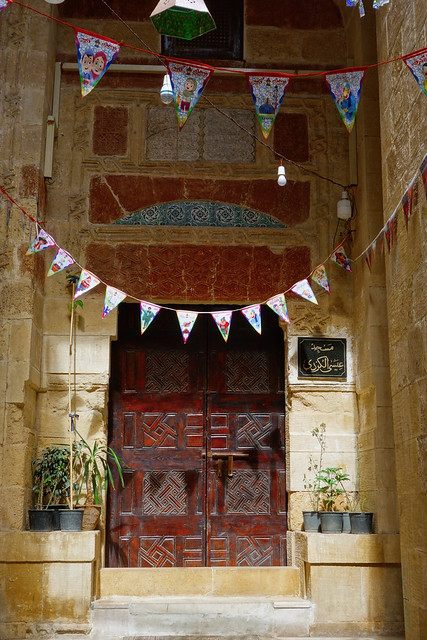We spent two days wandering around the Islamic Cairo, looking at grand mosques, massive gates, institutions of islamic studies, learning about sebils (public drinking water fountains), and getting overwhelmed by shopkeepers in the hans and souks....The highlights were the two beits (mansions). Their geometric designs are particularly refreshing and pleasing, oases to the hustle and bustle of the streets.
At the Al Azhar Mosque I had to don a hijab for the first time. I initially refused, on principle. John went inside to check it out. He returned immediately to get me -- "it's worth it". We had never been to a more relaxed mosque before. It was filled with people of all ages, male and female, everyone was doing their own thing, with complete ease, from studying the koran to sleeping. It's more like a community center. The only rule seems to be women in tightish trousers have to be covered. Such irony!
The fortress and Mosque of Ibn Tulun and its ziggurat minaret and corinthian columns.



The Gayer-Anderson House. The view through the grills of 2nd floor harem rooms sparks the imagination




Mosque of Al-Refaei. The last Shah of Iran is buried here.



"Waiting for the Rain to End" near the Mosque-Madrassa of Sultan Hassan.

Mosque-Madrassa of Sultan Hassan




Into the souks.


The monumental gate Bab Zuweila.

Unloading big sheets of leather at the shoemakers' workshops.

Bayt Al-Sehemi (House of Suhaymi) with high ceilings and beautiful tiles,and wooden beams and screens.







Gate Bab al-Futuh.

The Mosque of al-Hakim.

A former Sebil (free water fountain) on Al Fatemi Street.

Bicycle bread delivery (and more) on Al Fatemi Street.



We did a bit of shopping at the Khan el-Khalili Bazaar.

Al-Azhar Mosque and University


Sultan Al-Ghuri Mosque and surrounds.


Sebil of Muhammed Ali Pasha.

A few early morning street shots from Islamic Cairo.






Tahrir Square.



2 comments:
I am impressed you were able to go into the mosque. When I tried to enter a mosque in India, I was able to go into the courtyard but not the building.
I love the picture of the guy on the bike with the rack of bread.
@Liz, our experience has been that there is never any consistent rule. The mosques make up their own rules about where/when infedel men/women can go in what clothing.
Post a Comment